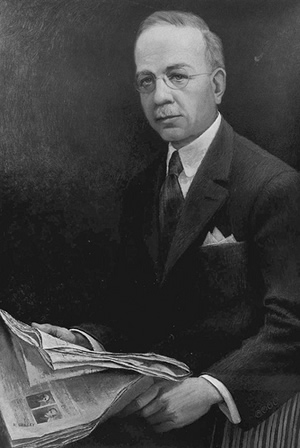AEJMC History

1931 Conference Photo
On November 30, 1912, a group of 18 journalism educators voted to create an organization called the American Association of Teachers of Journalism. The association’s mission was two-fold: to hold an annual conference of those interested in the teaching of journalism, and to collect statistics relating to schools, courses and teaching in journalism.

Willard G. Bleyer
Willard G. Bleyer of the University of Wisconsin at Madison, who spearheaded the movement to create the group, was elected the first president. Dues were set at $1 per year for AEJMC members at the 1931 conference.
Through the years the group grew steadily, and by 1924 had passed a resolution (proposed by Bleyer) to create a Committee on Research for the association and devote part of the annual conference program to presentation of research results. The next step in this research focus was the creation of a journal to showcase the best research in the field. Originally called the Journalism Bulletin, the first editor was Lawrence Murphy of the University of North Dakota. Dues were raised to $3, with $2 going to support the new journal.
In 1950, AATJ was renamed the Association for Education in Journalism and in 1964, the membership approved a new constitution that created special interest divisions and elected standing committees in AEJMC’s three key areas: Research, Teaching Standards, and Professional Freedom and Responsibility. At the 1965 convention, AEJMC approved its first 10 divisions: Advertising, Communication Theory and Methodology, International Communication, Graphic Arts, History, Magazine, Newspaper, Public Relations, Radio-Television Journalism, and Secondary Education. The divisions would plan convention programs in their areas, and were to report on these activities to the elected standing committees. In 1982, the association added and Mass Communication to its name to reflect the rapid changes taking place in the field.
In January 1999, the association purchased a 6,500 square-foot office building in Columbia, South Carolina, for its first permanent headquarters at a cost of $307,000. One year later fundraising to pay down the $218,000 mortgage on the building had netted more than $20,000 from individual AEJMC members, and $150,000 from three foundations: The William Randolph Hearst Foundation, The Freedom Forum, and The Gannett Foundation.
Through the years, the organization continued to adapt to meet the demanding and rapid changes in the field of journalism and mass communication. As AEJMC entered the Year 2000, it had grown to some 3,300 members worldwide and was publishing three quarterly research journals, two annuals and six newsletters each year. The future looked especially exciting as AEJMC added online publishing to its list of accomplishments with the Fall 2000 issue of Journalism and Mass Communication Abstracts.
In 2006, AEJMC ventured farther into uncharted digital terrain with an updated web site, and in 2007 with the addition of an online forum, news center and job board. Annual conventions have produced record numbers for the association with more than 2,600 attending the 2007 Annual Convention in Washington, DC.
From 2007 to 2008, the association designed a strategic plan to help shape and guide the future of the association. The plan was the foundation for initiatives highlighting new areas of focus in research, outreach and diversity. In 2009, the President’s Advisory Council was formed to allow the president to weigh in on important issues central to the association’s mission. The association’s program, AEJMC Emerging Scholars, awards research and teaching grants to encourage innovative and timely projects in journalism and mass communication; and the AEJMC Equity & Diversity Award recognizes academic units for progress and innovation in racial, gender and ethnic equity and diversity in hiring, initiatives, climate, and institutionally embedded support.
The association has web and social media presence on X, Facebook, and Instagram. Each conference season, the association features a website devoted to promoting the summer AEJMC Conference. In 2020 the association had its first virtual conference due to health and safety issues resulting from the COVID19 world pandemic.
Today, the association continues evolution with the pace of a rapidly changing environment and discipline and serves members from all over the world with its programs, awards, divisions and interest groups and commissions.
 Print friendly
Print friendly






